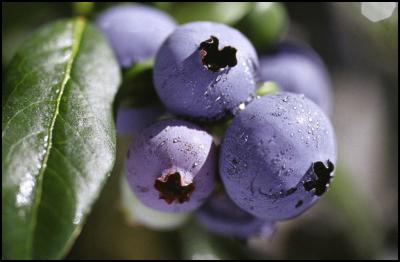Berried Treasure Benefits
13 Aug 03
Berried treasure benefits

Photo: HortResearch bred healthy Blueberries.
Members of HortResearch Palmerston North's Healthful Fruit Team are eating more berry fruit these days. That's because of their growing belief in the health punch packed by these small dynamos which research indicates could mean lowered risk of 'age-related' diseases.
It is the potential public health benefits of this research that brings added excitement to the work for team leader Tony McGhie. Dr McGhie is also sure that the ability to demonstrate a definite health response from berry fruit would give New Zealand manufacturers a competitive edge
Current studies by the HortResearch scientists are showing health benefits of anti-oxidant in red-pigmented berries such as blueberries, boysenberries and blackcurrants could have wide-reaching implications for long-term public health.
Dr McGhie said analysis of compounds from different cultivars of these fruits had confirmed their high anti-oxidant activity, with anthocyanins the main anti-oxidant component.
"There's good evidence to support claims that these compounds (anthocyanins) have a whole range of health benefits that include high anti-oxidant activity, anti-inflammatory activity and anti-cancer activity. They benefit the circulation - and protect the blood capillaries."
The research was about quality of life, not extending life, he said: "We don't believe we can make people live an extra five or ten years by eating berries but we do believe it is possible that by making the right dietary choices you can reduce the incidence of diseases such as cancer, cardio-vascular or heart disease, diabetes, arthritis and dementia.
"It's exciting to realise it's pretty hard to go past some of the research we see".
The attraction of berry fruits was that they "have particularly high concentrations of biochemical compounds that appear to have a variety of functions, and are packed full of nutrients, in a form that can be readily consumed." The benefits of other phytochemical components within berryfruit, such as vitamin C, mineral and fibre content are well documented. As with other fruits and vegetables, Dr MGhie said, it is when all these components work "in concert", preferably in their natural state, that these health properties work best.
There are many different type of anthocyanins and HortResearch investigations of blueberries show different patterns of varying levels of anthocyanins among various cultivars of the same fruit. Scientists grouped those with similar levels into 'families', and found that some had more combinations of what are known to be very strong anti-oxidants. "We strongly suspect that some cultivars of blueberry will be more healthy for you than others".
"Our goal now, since we can look at this pattern, is to understand what the different properties mean in respect to health," Dr McGhie said.
Measuring the known benefits of this anti-oxidant activity to see how cells are protected from oxidative stress damage in the body, blood and brain is one of the many challenges facing scientists in this research. Experiments to this end are already under way. These tests show one way these anthocyanins might function, completely separate from their anti-oxidant properties, is in increasing cell repair activity.
A further challenge is to select phytochemical combinations with the highest health properties and pass this information onto breeders to allow them to produce the new cultivars with enhanced benefit to both consumers and growers.
Dr McGhie said that while fresh is best, it is possible to incorporate the goodness of fruit into other food products. HortResearch's scientists work with companies to ensure the health benefits in the berries are retained through the manufacturing process to the end food product, whatever that may be.
"We want the companies we work with to grow the most beneficial and healthy cultivars, and the companies want to have premium profits so everyone benefits."
[605 words]


 Hugh Grant: Navigating Digital Adoption In New Zealand - Embracing Change For A Bright Future
Hugh Grant: Navigating Digital Adoption In New Zealand - Embracing Change For A Bright Future Dawn Aerospace: Historic Flight - Breaks Sound Barrier And Global Records
Dawn Aerospace: Historic Flight - Breaks Sound Barrier And Global Records SEEK: SEEK NZ Employment Report - October
SEEK: SEEK NZ Employment Report - October University of Auckland: Protecting Young Minds With AI
University of Auckland: Protecting Young Minds With AI Greenpeace: Greenpeace Calls On Fonterra Investors To Consider Big Picture With Giant Puzzle
Greenpeace: Greenpeace Calls On Fonterra Investors To Consider Big Picture With Giant Puzzle Hugh Grant: How New Tech Helps Kids Love Soccer More
Hugh Grant: How New Tech Helps Kids Love Soccer More



